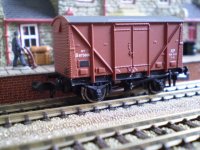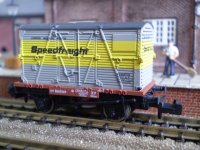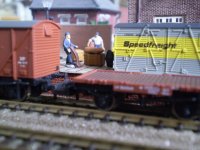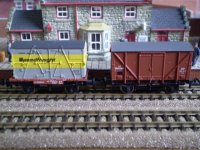One each of these authentic BR goods wagons from the Graham Farish standard range. Since freight
first travelled on the iron road back in the early Victorian era, railway companies had used wooden-bodied
vans to carry boxes and crates and packages of all kinds. The goods inside would be protected from the
weather outside, and from pilfering by any light-fingered miscreants who might otherwise have been tempted
to help themselves to an item or two, while the vans made their leisurely way from A to B with a stop or two
along the way. And a century or so later, in the post-war world of the 1950s, this was still pretty much the
way things were done. By now the old private companies had been swept away, of course, and the railways
of Britain had become British Railways. Wartime damage and neglect had left much of the system in a
sorry state, with the rolling stock in desperate need of renewal and replacement. BR lost no time in
embarking on a major construction program of every type of goods vehicle imaginable, and amongst these
shiny new wagons were a batch of 12-ton vans designed for carrying fruit. The van bodies were made from
the austerity era's top luxury material, plywood, and unlike most vans they not only had large ventilators
on the ends but also a row of small ventilators low down on the sides. This kept perishable cargo such as
fruit nice and cool, although in practice the vans were deployed just as frequently in general traffic as they
were in the specialised role for which they were designed.
Fast-forward a decade or thereabouts, to the early 1960s, and the fruit vans were still going strong. But by
now BR was looking to the future rather than the past, and building a new generation of goods vehicles for
a modern era. To fight off ever-increasing competition from road transport, they had to move freight by rail
as quickly and efficiently as they could, and they reckoned that the way ahead was containerisation. No
more time-consuming loading and unloading from lorry to wagon and back again, instead the customer
just loaded the goods into a shipping container at his premises. The container could then be loaded on and
off lorries and railway wagons on its way to its destination without the goods ever being handled at all.
Genius! So BR built containers in various shapes and sizes, and flat wagons called 'conflats' to load the
containers on to. The wagons carried the bauxite livery denoting vehicles fitted with vacuum brakes, but
the containers were painted up in a variety of colour schemes. Our model is of a larger 'BD' type
container in the smart grey & yellow 'Speedfreight' livery. For a few years the conflats and the fruit vans
would have run alongside each other, until containerisation took over and the old vans were shunted off to
the scrapyard. Soon the containers would get much bigger, needing special bogie wagons to carry them, and
the old containers and conflats would be gone too, along with the steam locos and the first-generation
diesels which had hauled them. But you can recreate the changing world of 1960s freight trains on your
layout with our BR Goods Set.
|




